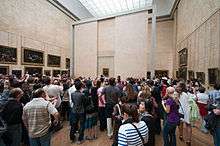Art world


The art world is composed of all the people involved in the production, commission, presentation, preservation, promotion, chronicling, criticism, and sale of fine art. Howard S. Becker describes it as "the network of people whose cooperative activity, organized via their joint knowledge of conventional means of doing things, produce(s) the kind of art works that art world is noted for" (Becker, 1982). In her book, Seven Days in the Art World, Sarah Thornton describes it as "a loose network of overlapping subcultures held together by a belief in art. They span the globe but cluster in art capitals like New York, London, Los Angeles, and Berlin."[1] Other cities that can be classified as "art capitals" include Beijing, Brussels, Hong Kong, Miami, Paris, Rome and Tokyo; due to their large art festivals, followings and being centers of art production.
The notion of the singular art world is problematic, since Becker [2] and others have shown, art worlds are multiplicities, they are globally scattered, constantly in flux, and typically operating independently of each other: there really is no center to the art world any more. In her analysis of the "net art world" (referring to network-aided art or net art Amy Alexander states "net.art had a movement, at the very least it had coherence, and although it aimed to subvert the art world, eventually its own sort of art world formed around it. It developed a culture, hype and mystique through lists and texts; it had a centre, insiders, outsiders, even nodes. This is of course not a failure; this is unavoidable: groups form; even anarchism is an institution." [3] Art worlds can exist at the local and regional levels, as hidden or obscured subcultures, via primary and secondary art markets, through gallery circuits, around design movements, and more esoterically as shared or perceived experiences.
The one globalized, all-encompassing art world does exist – but it does so as a myth; more accurately, there are multiplicities of intersecting, overlapping, self-similar art worlds, each expressing different views of the world as they see it.
New York Magazine art critic Jerry Saltz has referred to William Powhida's and Jade Townsend's drawing Art Basel Miami Beach Hooverville as "a great big art-world stinkbomb."[4]
Theory
The term "art world" is a product of the Institutional theory of art. It originates with the theories of American art critic and philosopher Arthur Danto. In 1964 Danto published an essay "The Artworld," in which the term "artworld" was coined, meaning cultural context or "an atmosphere of art theory".[5] It has had considerable influence on aesthetic philosophy and, according to professor of philosophy Stephen David Ross, "especially upon George Dickie's institutional theory of art." Dickie defines an art work as an artefact "which has had conferred upon it the status of candidate for appreciation by some person or persons acting in behalf of a certain social institution (the artworld)" (p. 43.)[6]
The central core of Danto’s The Artworld is "artistic theory", which elevates things to the world of art (or art world).
Danto writes: "these days one might not be aware he was on artistic terrain without an artistic theory to tell him so. And part of the reason for this lies in the fact that terrain is constituted artistic in virtue of artistic theories, so that one use of theories, in addition to helping us discriminate art from the rest, consists in making art possible" (Danto, The Artworld, p. 3).
See also
- art perceptinon
- perceptor
References
- ↑ Thornton 2008
- ↑ Becker, Howard S. Art Worlds. Berkeley: University of California Press, 1982. ISBN 0-520-05218-8. Cited in Sanjeck (1999).
- ↑ Alexander, Amy. net art history (2001) Nettime.org
- ↑ Saltz, Jerry. "William Powhida Is Making Fun of Me, And I Love It". New York Magazine. 9 March 2010.
- ↑ http://plato.stanford.edu/entries/art-definition/
- ↑ https://books.google.com/books?id=vDdZNwTmEqUC&printsec=frontcover&redir_esc=y#v=onepage&q=danto&f=false
Bibliography
| Wikiquote has quotations related to: Art world |
- Sanjeck, David. "Institutions." Key Terms in Popular Music and Culture. Malden, MA: Blackwell Publishers, 1999. ISBN 0-631-21263-9
- Thornton, Sarah. Seven Days in the Art World New York: WW Norton, 2008.